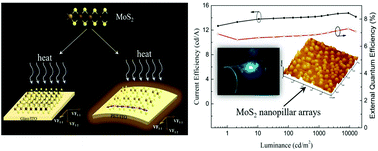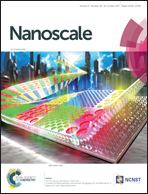High-performance flexible inverted organic light-emitting diodes by exploiting MoS2 nanopillar arrays as electron-injecting and light-coupling layers†
Abstract
Inverted organic light-emitting diodes (IOLEDs) on plastic substrates have great potential application in flexible active-matrix displays. High energy consumption, instability and poor electron injection are key issues limiting the commercialization of flexible IOLEDs. Here, we have systematically investigated the electrooptical properties of molybdenum disulfide (MoS2) and applied it in developing highly efficient and stable blue fluorescent IOLEDs. We have demonstrated that MoS2-based IOLEDs can significantly improve electron-injecting capacity. For the MoS2-based device on plastic substrates, we have achieved a very high external quantum efficiency of 7.3% at the luminance of 9141 cd m−2, which is the highest among the flexible blue fluorescent IOLEDs reported. Also, an approximately 1.8-fold improvement in power efficiency was obtained compared to glass-based IOLEDs. We attributed the enhanced performance of flexible IOLEDs to MoS2 nanopillar arrays due to their light extraction effect. The van der Waals force played an important role in the formation of MoS2 nanopillar arrays by thermal evaporation. Notably, MoS2-based flexible IOLEDs exhibit an intriguing efficiency roll-up, that is, the current efficiency increases slightly from 14.0 to 14.6 cd A−1 with the luminance increasing from 100 to 5000 cd m−2. In addition, we observed that the initial brightness of 500 cd m−2 can be maintained at 97% after bending for 500 cycles, demonstrating the excellent mechanical stability of flexible IOLEDs. Furthermore, we have successfully fabricated a transparent, flexible IOLED with low efficiency roll-off at high current density.



 Please wait while we load your content...
Please wait while we load your content...